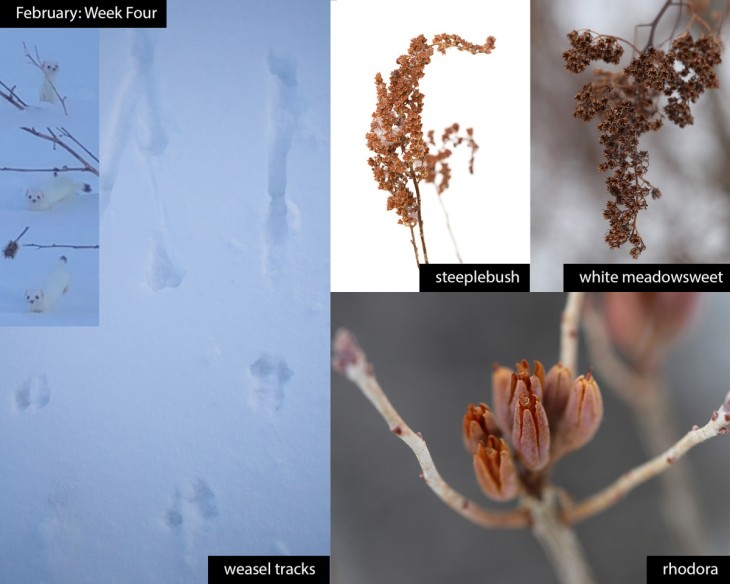This week in the woods, we took a look at some zig-zagging weasel tracks after watching the culprit periscope its way out of deep snow, eyeball us, and scamper away. In these grainy smartphone video stills, the more diminutive size and tail shorter than a third of this weasel’s body length indicate that it is most likely an ermine – also called a short-tailed weasel or stoat – rather than the similar but more uncommon, larger, and aptly named long-tailed weasel. Both species molt from their summertime brown into wintertime white in November, leaving the tip of the tail black. While the white provides camouflage in snow from owls, hawks, and foxes, the black tail tip creates a diversion for predators away from a weasel’s body. However, because a shorter photoperiod (length of daylight) rather than weather triggers the winter molt, weasels in their bright white are vulnerable to predators in winters with inconsistent snow cover. Weasels hunt nearly nonstop, traveling up to 3 miles a day to find prey during times of scarcity and eating at least 40 percent of their weight in food daily. Their tubular shape and slenderness allow them to worm their way into the underground tunnels of mice and voles during the summer and their subnivean burrows in the winter. Their tracks can be highly irregular and entertaining to follow, with disappearances into neat round holes and reappearance elsewhere, abrupt changes in direction, doublings back, leaps and bounds, and periodic drag marks from their long bellies. Among the variability, look for small, paired tracks with five claws on each foot, hind paw tracks falling mostly atop front tracks. (For more on winter weasels, see Susan Shea’s 2020 Outside Story article.)
Without their flower colors evident in the winter, white meadowsweet and steeplebush often confuse observers trying to identify them. (Steeplebush sometimes even bears the alternative common name meadowsweet, in addition to hardhack.) These fellow members of the Spiraea genus have similar flowers and fruits, with tiny follicles opening along one seam and arranged in groups of five, and can pioneer the same disturbed sites and wetland edges. Steeplebush, however, has pointed, steeple-like flower clusters, fuzz all over, and shorter and more closely spaced branches; white meadowsweet doesn’t form a spike or have fuzz on its twigs or leaves, only some on its stem. While often assumed to be wildflowers, these plants are shrubs; if you scratch their bark in the winter, you’ll still see some green and can look forward to new leaves and shoots in the spring.
Even with so many plants buried beneath snow or brown and dried, we can still appreciate their skeletal states and remember that blooms and greens will return. Another shrub, rhodora, or Canadian rhododendron, bears the promise of bold bright purple and pink blossoming among the bogs and mountainous habitats it occupies. Throughout the autumn and winter, its hard, ridged fruit capsules, shown here, disperse seeds to the wind.
What have you noticed in the woods this week? Submit a recent photo for possible inclusion in our monthly online Reader Photo Gallery.


